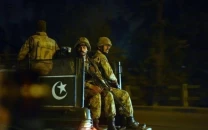CDA asked to explain pollution in Rawal Lake
IHC also seeks details of illegal activities, encroachments near the lake

Rawal Lake. PHOTO: FILE
This was directed by Islamabad High Court’s (IHC) Justice Shaukat Aziz Siddiqui as he took up petitions filed by Pir Fida Hussain and local resident Jahangir Abbasi.
Release of untreated water in Sutlej damages marine life
In his petition, Fida argued before the court that residential areas established in the catchment area of the Rawal Lake were contaminating water in the lake.
According to the petition, sewerage from areas such as Bani Gala, Bhara Kahu, Malpur, Phulgran and surrounding areas were drained into the lake, polluting it.
It further said that toxic waste from as many as 170 poultry farms set up along the Korang River are also drained into the riverine and it ultimately ends up in the Rawal Lake. Upon court’s query, Capital Development Authority (CDA) Additional Legal Advisor Amir Latif Gill conceded that sewerage from the diplomatic bloc also ends up in the lake, contaminating its water.
Justice Siddiqui observed that such toxic waste is hazardous for both, humans and aquaculture of the lake.
He directed the CDA to submit a comprehensive report, supported with satellite imagery detailing the encroachment of catchment areas of the lake over the years.
The court also sought details of illegal activities near the Rawal Lake and asked the CDA to apprise the court about the major sources polluting the Rawal Lake.
Last year, panic buttons were pushed when hundreds of fish floated to the surface of the lake. It prompted a mass investigation while the authorities even shut supply from it to Rawalpindi for a few days to ‘protect consumers against potentially poisoned water’.
However, subsequent test results showed that there was no poison in the lake.
Plastic pollution in Pakistan
Samples from the Rawal Lake, collected by the Pakistan Council for Research in Water Resources (PCRWR) — a research organisation which works under the Ministry of Science and Technology —found that the water had high levels of bacteria and turbidity, making it unfit to consume.
Tests by the National Agricultural Research Centre (NARC) also found that there was no toxic chemical present in the water.
Published in The Express Tribune, June 26th, 2018.

















COMMENTS
Comments are moderated and generally will be posted if they are on-topic and not abusive.
For more information, please see our Comments FAQ